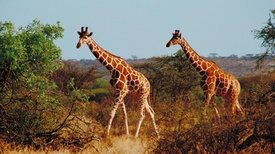撰文\播音:贾森·G·戈德曼(Jason G. Goldman)
翻译:陈美娟
审校:郭晓
The giraffe is an icon of the African savannah. The lion is the top predator of the ecosystem. Both animals face uncertain futures, and both are subjects of intense, ongoing conservation work. Now a study suggests that saving one might mean bad news for the other. [Zoe Muller, Population structure of giraffes is affected by management in the Great Rift Valley, Kenya, in PLOS One]
长颈鹿是非洲热带草原上的标识。狮子是生态系统里的头号猎食者。这两种动物都面临着不确定的未来,而且都是紧张的、持续进行的动物保护工作的对象。如今有研究表明,救助其中一种动物可能不利于另一种动物的生存。
"When I was out in the field, I heard anecdotes from people that in one of my study sites there were very few juvenile giraffes, because apparently the lions in the area had developed a preference for taking young giraffes."
“当我在野外工作的时候,我听在其中一个研究点做研究的人说,当地已经很少有幼年长颈鹿了,因为,很显然,那里的狮子开始偏好吃它们了。”
University of Bristol biologist Zoe Muller. Working in Kenya's Great Rift Valley, she focused her attention on two neighboring sites: a national park with lots of lions, and a privately owned conservancy with no lions.
来自布里斯托尔大学的生物学家Zoe Muller如是说。她在肯尼亚的东非大裂谷工作,她的研究重心在两个相邻的区域:一个是生存着很多狮子的国家公园,另一个是没有狮子的私人所有保护区。
In the lion-free conservancy, 26 percent of the giraffes were less than one year old. But in the lion-filled park, juvenile giraffes made up only 5 percent of the species’ population.
在没有狮子的保护区,26%的长颈鹿年龄小于一岁。但在遍布狮子的园区,幼年长颈鹿仅仅占据了该种群数量的5%。
"So I was able to show that in the presence of lions, the number of juveniles is severely reduced, by actually 83 percent. Which was a lot higher than I thought it would be. Quite shocking, actually."
“因此我可以证明的是,狮子的存在使幼年长颈鹿的数量大量减少了83%。这比我原先设想的还要更多。这真的很让人震惊。”
Giraffe populations have declined by some 40 percent in the last 30 years, with fewer than 98,000 individuals left in the wild. In recognition of those figures, they've recently been classified as "vulnerable," that is, likely to become endangered.
在过去30年里,长颈鹿总量已经减少了40%,仅剩下不足98,000只野生个体。这些数据表明,近年来长颈鹿已经可以被划分到“易受伤害”级别里,换句话说就是它们可能成为濒危动物。
The ongoing loss of juveniles could lead to a situation where the population crashes, since population growth and stability both rely on having enough calves survive to sexual maturity—so they, too, can breed and produce offspring of their own.
幼年长颈鹿数量的不断减少可能导致种群数量锐减的情况发生,因为种群数量的增长和稳定性均有赖于足够数量能活到性成熟的幼崽,这样,它们也可以生育自己的后代。
The study compares only two sites in East Africa. But it highlights the extreme complexity of wildlife management in Africa, where the recovery of one species could potentially come at the cost of another.
这项研究只对比了东非两个实验选址的情况。但它着重强调了非洲野生动物管理的极端复杂性,即一个种群的恢复可能是以另一个种群的消亡为代价。
"Unfortunately, in East Africa especially, most of the conservation areas these days are fenced and enclosed. And so this is going to become an increasingly more common problem, where we find that predators are being enclosed in specific areas."
“不幸的是,尤其是在东非,大多数的保护区现在都被围栏围住了。所以,捕食者被围在特定区域这种现象会成为一个越来越常见的问题。”
Allowing for the conservation of both species in the same areas is thus a tricky proposition. Muller says that one possibility might be to translocate giraffes into and out of lion-free areas, or to translocate lions into and out of places with lots of giraffes. If we do that, we may help ensure the two species’ survival. But are they still truly wild?
因此将这样的两个物种放到同一片区域是个很棘手的问题。Muller说,其中一个可能的解决方法是将长颈鹿转移进或移出没有狮子的区域,或者将狮子转移进或移出有很多长颈鹿的区域。这么做的话,我们可能可以帮助两种物种生存下来。但这样的话,他们还是野生动物吗?

 京公网安备11010502039775号
京公网安备11010502039775号  京公网安备11010502039775号
京公网安备11010502039775号 
















